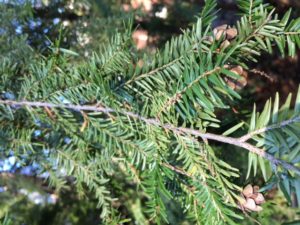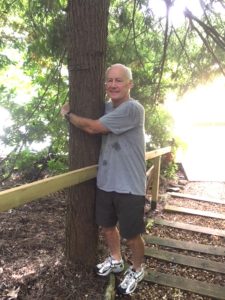 I set out to write about saving the hemlocks. It’s no secret that our beloved eastern hemlocks are being killed by the thousand by a tiny insect called a wooly adelgid. But the deeper I got into the research about the hemlock and the devastating infestation of adelgids, the more I realized that the real story is not about the trees but about the people trying to save them.
I set out to write about saving the hemlocks. It’s no secret that our beloved eastern hemlocks are being killed by the thousand by a tiny insect called a wooly adelgid. But the deeper I got into the research about the hemlock and the devastating infestation of adelgids, the more I realized that the real story is not about the trees but about the people trying to save them.

This is the hemlock situation in a nutshell: In the l950’s a bug called a hemlock wooly adelgid came to the U.S. from southern Japan. It latched onto the hemlock and within a startlingly short period of time, began killing trees. Fortunately, it feeds only on the eastern hemlock; the two North American western hemlock species do not seem to be susceptible. In the intervening years, hundreds of thousands of hemlocks have died with no apparent natural stop in sight.
Enter the people. Saving the hemlock is an incredibly difficult, expensive and time consuming proposition. There are chemicals which have proven effective in eradicating the deadly adelgid but it has to be administered one tree at a time. With an estimated 19 million acres of primary hemlock forests in 20 eastern states, this seems like an overwhelming and hopeless task. BUT, and this is the good and the most important part of this story, there are many, many people working endlessly and tirelessly to save the hemlocks anyway.
But, it does make you stop and wonder, why? What is it about a hemlock tree that so inspires someone to dedicate all their extra hours and extra dollars to save it. What’s another tree gone? What’s another species gone extinct? Who are these people, these angels for the environment?

One of them is my very good friend, Alan Barnes, who is a volunteer for Save Georgia’s Hemlocks. This organization was founded in 2009 and in their most recent newsletter they say “now 10 years later, through the dedication of many volunteers and partners, we have made remarkable progress with our Hemlock Help Program established in all 19 Georgia counties within the native hemlock range, more than 300 trained Facilitators providing hand-on assistance in Georgia and other southeastern states, and our Hemlock Help Line and web site serving the entire U. S.”
The organization offers a three pronged approach – cultural (being wise stewards of the trees and land), biological (predatory beetles and working to develop resistant strains of trees) and chemical. They work on both public and private lands to save as many trees as possible.
Chemical control is effective, killing up to 95 – 99 percent of the adelgids on treated trees. But applying chemicals tree by tree takes a lot of time and is expensive. And, the treatment only lasts from 2 – 6 years, depending on the chemical used. There was great hope that predatory beetles, also introduced from southern Japan, would provide the “stop gap” needed to halt the seemingly unstoppable adelgid. Although scientists are still working on this approach, it has not proven to be a quick solution to the problem. Currently, much hope (and resources) are being put into developing resistant strains of hemlocks that could be replanted not only in state and federal lands but on private land as well.
Without a “quick solution” and continuing devastation by the adelgid, it makes you ask, why bother? I mean, really, what can we do to stop it? But thank God, there are people who believe that saving even one tree is worth the effort. And the combined efforts of these people may be the difference between the continued existence of the eastern hemlock and possible extinction of yet another species. Thank God there are people, like Alan Barnes, who believe that the fight for even one tree is a worthy fight. Thank God that there are people who refuse to be squelched by overwhelming odds and who provide hope for our future.

No matter what your political views are, no matter what you think about the politics of our warming planet, it’s people like those working with Save Georgia’s Hemlocks who are our guiding lights and our hope for a future where all living things are revered and loved for precisely who and what they are.
For more information about Save Georgia’s Hemlocks, please go to their website http://savegeorgiashemlocks.com. It is an excellent site, providing much information about the problem and offering help to private land owners to save the trees on their property. They welcome both interest and donations.
\

Such a great topic; I remember when Dave worked tirelessly with the Chattooga Conservancy on this issue. He brought it to my attention and now you are bringing it to others. Good for you!